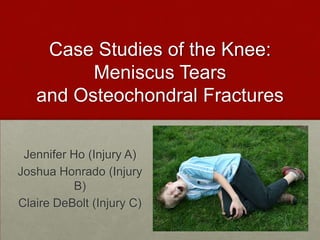
Case Study Meniscus Tears And Osteochondral Fractures
- 1. Case Studies of the Knee: Meniscus Tears and Osteochondral Fractures Jennifer Ho (Injury A) Joshua Honrado (Injury B) Claire DeBolt (Injury C)
- 2. Knee aNATOMY
- 3. KNEE ANATOMY
- 4. Injury a • 20 year old male track athlete • 5k and 10k distance events • 3 years prior, consistent discomfort and pain along L medial joint line • 4 weeks prior, escalated to extreme pain • Spoke with ATC and consulted physicians • Preoperative exam and MRI revealed a medial meniscus tear • Did not respond well to conservative treatments • Surgery on Jan 21, 2011
- 5. Injury B • 20 year old male track athlete • High jump, triple jump • Athlete c/o pain x1wk and swelling in R knee after playing basketball, unable to run/ jump w/o pain (pain similar to initial surgery) • Spoke with ATC and consulted physicians • Preoperative exam and MRI revealed possible medial meniscus tear • Did not respond well to conservative treatment and Celebrex • Surgery on October 21, 2010
- 6. INJURY C • Previous knee injuries • Pain and effusion in the right knee; no specific mechanism • MRI results: anterolateralmeniscal abnormality • Pain over the lateral joint line; negative for special tests • Diagnosis: Lateral meniscal tear • Arthroscopic menisectomy
- 7. MenisCectomy
- 8. MENISCECTOMY IMAGING
- 9. Surgery a, boUTCOMEs • Partial meniscectomy of the L medial meniscus • Arthroscopy revealed complex degenerative tear of the posterior horn of the medial meniscus in the white-white zone • Horizontal and vertical tears • Partial meniscectomy of R medial meniscus • Arthroscopy revealed mild superficial fraying of posterior horn of medial meniscus in the white-white zone • Same area where original meniscectomy was performed • Originally resected only the torn unstable parts of the medial meniscus
- 10. SURGERY A, B
- 12. Screw Fixation and Microfracture Basis
- 14. General rehabilitation plan • Decrease Pain and Reduce Swelling; RICE • Knee Joint Mobilizations • Reduces arthrofibrosis • Flexibility/ ROM • Muscular Strength • Quads, hamstrings, abd, add, gastroc • Neuromuscular Control; Proprioception • Cardiorespiratory Fitness • Non-weight bearing • Functional Progression • Sport-specific skills
- 15. Rehab a • Week 1-2: Control pain and swelling, core, ankle and hip passive ROM and strength, balance • Modalities: russian stim, micromassage, cryopress, soft tissue massage • Gentle stretching, clamshells, calf raises, SL airex balance • Week 3-8: strengthening and balance, cardiovascular fitness, effusion reduction • Cycling, swimEx, elliptical, decreased activity due to persistent effusion • Prone hangs (knee extension), 4 way ankle TB exercises, DL squats, russian twists, monster walks, forward/backward walks • Jump rope, DL/SL squats, lunges, increased time on cardio workouts • Modalities: graston, microflush, soft tissue massage • Week 9-11: reduce posterior capsule tightness, proprioceptive + dynamic stability, cardiovascular fitness • DL/SL squats, airex lunge, tennis balance, step-ups, walking supermans, knee grabs, ABC skips, slide board, AlterG progression • Modalities: graston • Week 12-Present: functional progression, return-to-sport • FMS (21), cleared to begin running • Currently running on the track every other day, slowly adding mileage
- 16. REHAB B • Rehabilitation was a lot faster than initial surgery • Swelling reduced and full ROM by 5th week • Winter break slowed progression • Focused on proprioception (SL balance), box jumps, progression of short step approaches • 4 months after surgery cleared PT eval with FMS screening for in-door high jump • Later cleared for outdoor long-jump
- 17. REHAB C • Weeks 1-3: Decreasing pain and swelling, achieving full extension, slowly increasing ROM, increasing quad control and VMO tone, maintaining glute, hip • Modalities (Russian, microcurrent); Soft tissue mobilization; Cryotherapy • Ankle pumps; Quad and HS sets; Adductor sets, supine hip flexion, prone glute activation; Bike (ROM) • Week 3: PWB (50%), ROM 0-30; Goals: effusion control, maintain extension, gait activity • Extension exercises • Week 4-7: Passive ROM 1-110; Goals: effusion control, soft tissue and joint mobilization, maintain full extension, FOCUS: VMO • Wall slides • Heel slides, Double leg bridges with squeeze, weight shifts, calf raises, balance
- 18. REHAB C • Week 7; X-Ray 2: Screw and fragment intact; FWB permitted • Swim-Ex • Balance Exercises • SL exercises • Week 8; X- Ray 3:No evidence of hardware complication; etc. No pain, little swelling observed. • Weeks 9-12: Maintained rehab program • 3-way hip, clamsheels (TB), DL bridged (med ball), SL bridges, SLR, TB side steps, calf raises • Swim Ex: 4 way hip, flutter and bike kicks, jogging
- 19. REHAB c • SURGERY 2: Hardware removal • Lower extremity strengthening; proprioception • 3 way hip, clam shells, squatting, side stepping, wall sits, bridging, calf raises, balance exercises • Lunges, bridge walk-outs, power-ups, monster walks, slide-board, squatting
- 20. aTHLETE a: cURRENT STATUS • As of 11.5 week post-op he was discharged from PT and began to slowly increase mileage • Currently progressed to 3 miles every other day • Occasionally feels discomfort from the site of partial meniscectomy when speeding up
- 21. Athlete b: current status • Full participation in outdoor track and field • Does high-jump, long jump, but no longer does triple jump • Recently had a case of shin-splints • Occasionally feels pain discomfort from site of meniscectomy
- 22. Athlete C: Current Status • ~5 weeks post surgery • Progressing smoothly • Alter G: 50% 60% • Expected to return to full play by summer ball
- 23. THE END